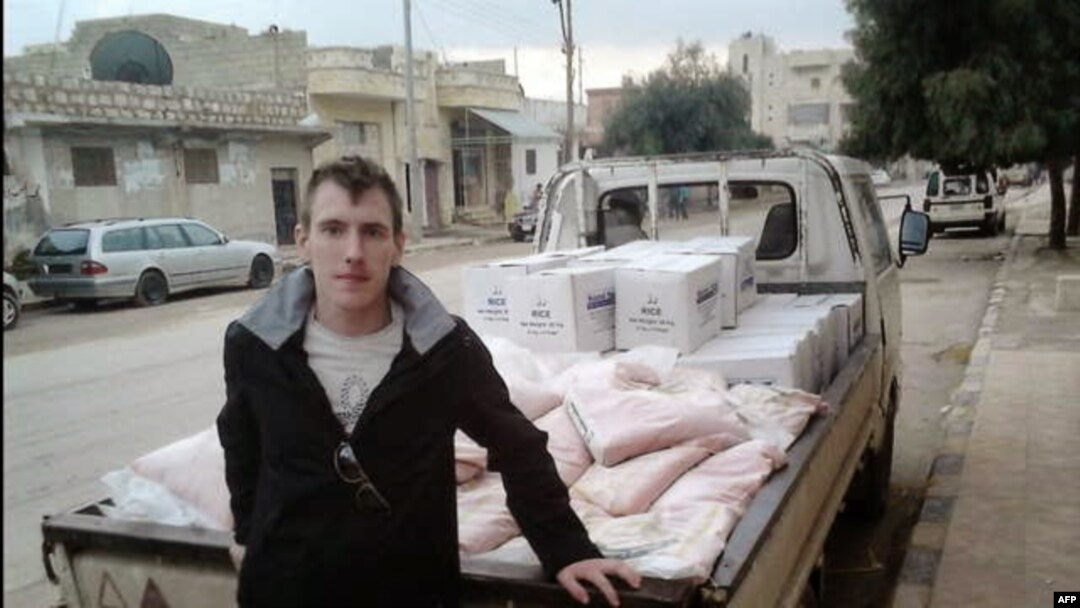Islamic State (IS) militants from Britain and France are suspected of participating in a video that showed the mass beheading of Syrian hostages and the killing of American aid worker Abdul-Rahman (Peter) Kassig, according to British and French media reports.
The brutal beheadings of around a dozen or more Syrian pilots and military officers were shown in the latest execution video from the IS group, released on November 16. The video also showed the severed head of a man that IS identified as Kassig, an American aid worker taken hostage in Syria last year.
France's "Le Figaro" reported on November 16 that French intelligence officials were looking into the possibility that one of the militants in the graphically violent video was a French national known as Abu Abdullah al-Firansi. Terrorism specialist Jean-Charles Brisard told "Le Figaro" that the man was a 22- or 23-year-old from Normandy who left France for Syria in August 2013.

An image from an Islamic State account on VKontakte showing a man believed to be Abu Abdullah al-Firansi.
On November 17, France's interior minister, Bernard Cazeneuve, said the militant in question was likely 22-year-old Maxime Hauchard.
Hauchard, a convert to Islam, is believed to appear in this video published in July, in which he said that he reached Syria without any difficulty and without any help from any third party. He said that his greatest reward would be to become a "martyr," dying while waging jihad.
In Britain, the authorities are investigating claims that a young British student from Cardiff in Wales could be one of the militants seen in the November 16 execution video. Police suspect the man could be 20-year-old Nasser Muthana, a former medical student who went to Syria with his 17-year-old brother, Aseel.
Nasser's father, Ahmed Muthana, said that one of the militants in the video that showed the beheadings of Syrian servicemen and the severed head of Kassig could be his son, but he could not be certain.
If the militant in the video was Nasser, then his son must be "mentally ill," Muthana told "The Guardian." Muthana told another British reporter that if his son had beheaded anyone in Syria, he should face the death penalty.
Nasser Muthana has appeared in a previous IS propaganda video.
In June, a local Cardiff imam said that Nasser and his brother Aseel had gone through a "very strange period when they said that they were becoming quite serious in their faith and then began to start to express certain views that were quite political."
Sheikh Zane Abdo from the South Wales Islamic Center said that the two young Britons had not attended his mosque for around two years before they went to Syria.
Another British militant suspected to have appeared in the exceptionally brutal video was the black-clad man known in the U.K. media as "Jihadi John." The militant, who keeps his identity hidden by wearing a black face mask, is believed to be responsible for the beheadings of at least five Western hostages, including Kassig.
According to the IS video, the mass beheadings took place in Dabiq in northern Syria. The town is of significance to IS, which believes that Dabiq will be the site of a grand, apocalyptic battle between Rome and an Islamic army. After the Muslims defeat Rome at Dabiq, the Day of Judgment will come.
Islamic State militants captured Dabiq in August and used the name of the town as the title for their English-language propaganda magazine.
In the November 16 video, IS militant "Jihadi John" references the prophecy when he says, "Here we are burying the first American crusader in Dabiq, eagerly waiting for the remainder of your armies to arrive."
-- Joanna Paraszczuk


